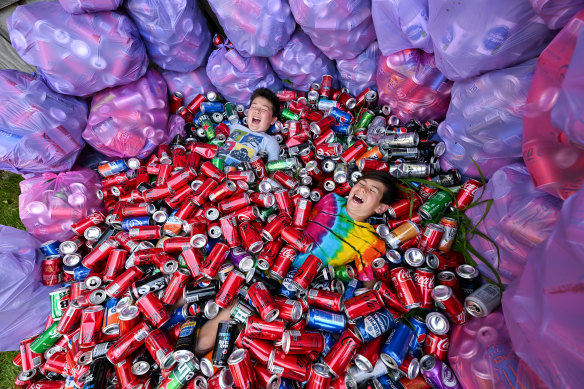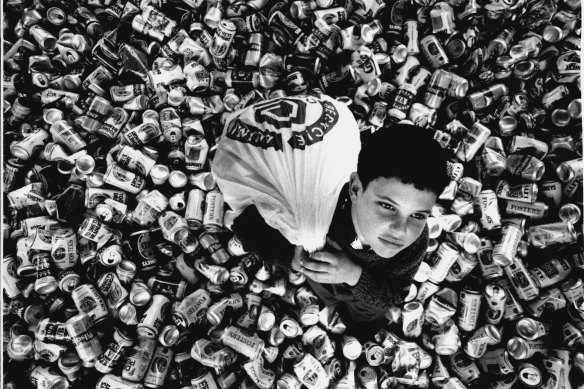Opinion
When kids get $20 from the tooth fairy, 10¢ to ‘cash a can’ in Victoria isn’t cutting it
Claire Heaney
WriterIt’s like I’m 10 all over again as I stoop to pick up discarded cans in the street. Decades on, the imperative isn’t so much to “Cash-a-can” for pocket money to buy mixed lollies at the milk bar. It’s more about trying to do my bit to help save the planet.
Since Victoria rolled out the Container Deposit Scheme on November 1, I no longer squeeze cans into my overflowing yellow co-mingled recycle bin or bottles into my purple bottle bin for kerbside recycling.

Canny hobby: Brothers Xavier (left) and Ashton Hanson, pictured in November, were planning to collect thousands of cans.Credit: Joe Armao
The other day, as I swooped on a Corona bottle, my eyes met my Millennial neighbour. Momentarily embarrassed, assuming she would think I was a desperado scrounging for bottles, I regrouped to tell her I would drop them off at the depot. We’re near a main street with bars so empty “travellers” are regularly dumped in planter beds or on fence posts. That childhood Keep Australia Beautiful indoctrination has stuck fast.
According to the state government, Victorians use 3 billion drink containers every year and many end up in landfill or waterways. Being a motivated recycler, I wanted to support this initiative promising cleaner and streamlined recycling.
But as the cans rattling around in my car boot testify, there are teething problems, and it does take commitment. The reverse vending machine closest to me keeps throwing a wobbly. Largely because it is overworked. Too successful, maybe?
Under the program, there are three ways to recycle most aluminium, glass, plastic, and carton drink containers between 150 millilitres and three litres at 10¢ each.

Cash-a-can was a phenomenon in the late 1980s and early 1990s.Credit: Steven Siewert
You can take them to a reverse vending machine and feed them in individually; if you have a handful of containers there are small businesses – florists, convenience stores, hotels and service stations – which take over-the-counter recycling; or if you’re a super-collector and have a trailer load you can head to a depot.
Containers cannot be crushed as the barcode needs to be read. You can leave lids on bottles.
My reverse vending machine is five kilometres away. It’s counterproductive to hop in a car and burn fossil fuel for the sake of a hundred containers, so we combine the trip with other tasks.
On my last visit, the machine would only take a few Heineken bottles and some plastic soft drink bottles. It baulked at cans.
I put through 29 bottles at 10¢ each for a $2.90 return. My husband pushes the donate button, sending the few dollars to charity. Every little bit helps and there are hundreds of charities to support.
I usually do this but, on this occasion, I was so frustrated I took the $2.90 Coles voucher. I might shout myself a Diet Coke.
Some people wouldn’t persevere, but I’ve seen kids propped on boxes feeding the machines. The scheme is changing habits, though I’m not sure if it’s enough for all children in an age when kids seem to get $20 from the tooth fairy.
As kids, we collected aluminium cans and stomped on them to sell by weight. They didn’t take up as much room. Mind you, a can of soft drink was a treat, so it took a long time to fill a bag. We had entrepreneurial friends who were super-collectors who would go out on family expeditions collecting aluminium cans at events.
Once a year we’d call the bottle-o, who would drop off crates, and we’d stack Dad’s Melbourne Bitter long neck beers. The bottles were refillable rather than recyclable. He’d return the long necks and the crushed cans.
It was seamless, but it was the extent of our recycling. We’d throw organic waste to the chooks and everything else into the Besser block incinerator. Notwithstanding the black toxic plumes of smoke threatening the freshly hung washing on the Hills Hoist, there was a lot less single-use packaging, more meals prepared from scratch, and we wore things until we grew out of them. We were all pyromaniacs in training.
In the late 1980s, Pat Cash fronted the Comalco Cash for Cans campaign with a play on his surname. Alcoa Australia also had a Cash-a-can. And then came kerbside recycling, and it’s hard to know what goes in where and what gets recycled.
I’m looking forward to the Victorian scheme’s expansion in August, with the network growing from 400 to 600 refund points. There are two new sites planned closer to my house. There’s an app you can download, and I will find a local charity to support.
In the meantime, we’re drawing (reusable) straws to see who next embarks on the trip up Hoddle Street to feed the erratic machine.
Claire Heaney is a Melbourne writer.
The Opinion newsletter is a weekly wrap of views that will challenge, champion and inform your own. Sign up here.